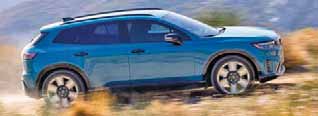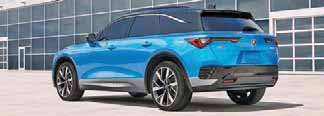


The strong performance for electric vehicles came mostly from newer models, such as the Equinox EV, Honda Prologue, top left, and Acura ZDX, top right.
New electric vehicle registrations surged 20 percent in March as consumers snapped up light vehicles in general before expected price hikes from tariffs on autos and parts, S&P Global Mobility said.
EV registrations, not including hybrid vehicles, numbered 115,758 in March, good for a 7.5 percent share of the U.S. light-vehicle market. That rose from 7.1 percent a year earlier, the data showed.
March EV registrations outpaced gains in the overall light-vehicle market, which increased 14 percent to 1.54 million vehicles, S&P Global Mobility said.
“March was way up across the industry, and I don’t think it’s coincidental that happened at the same time as all of these announcements on tariffs started.”
Tom Libby, S&P Global Mobility
Gasoline and diesel vehicles had a 78 percent share and hybrids accounted for 14.1 percent, the March data showed. The hybrid gain represented a 3.4 percentage point increase from the same month last year, the largest of any powertrain segment.
“March was way up across the industry, and I don’t think it’s coincidental that happened at the same time as all of these announcements on tariffs started,” said Tom Libby, an analyst at S&P Global Mobility.
President Donald Trump announced a 25 percent tariff on imported autos in early March.
Popular electric models, including the Chevrolet Equinox EV and Ford Mustang Mach-E, are imported from Mexico.
The strong performance for EVs came mostly from newer models, such as the Equinox EV, Honda Prologue and Acura ZDX, Libby said.
Older models from Tesla, Ford and Kia saw sharp declines.
The number of battery-electric models with 10 registrations or more grew to 78 in March from 55 a year earlier, the data showed. Notable additions included the Volkswagen ID Buzz minivan and the Jeep Wagoneer S.
Tesla had 1.1 percent gain
Tesla, the top EV brand, posted a 1.1 percent gain in March to 51,042 registrations following two months of declines, the U.S. data showed.
Tesla registrations fell 4.6 percent in the first quarter.
The Tesla Model 3 surged 157 percent to 18,686 vehicles in March, S&P Global Mobility said. The sedan was freshened early last year and in short supply during the U.S. factory switchover, Tesla said.
Tesla Model Y registrations fell 24 percent in March to 28,108 vehicles. The crossover was freshened early this year, and Tesla said supply shortages affected sales in the first quarter.
Chevrolet was the No. 2 EV brand, more than tripling sales to 8,478 vehicles in March versus a year earlier, S&P Global Mobility said. Ford slipped to third place in March from second in February.
Cadillac’s EV registrations grew 86 percent in March from a year earlier to 3,373 vehicles. The luxury brand now has four models: the Lyriq, Optiq, Vistiq and Escalade IQ. It was the No. 7 EV brand in March.
Because Tesla doesn’t break out U.S. sales, registration data serves as a proxy. Some other EV makers also don’t detail all of their EV sales by model.
The relatively stagnant share for battery-electric vehicles this year is a red flag, Libby said. EV share grew from 1.4 percent in 2019 to 7.7 percent in 2023, but growth then cooled, coming in at 8.8 percent last year.
In the first quarter, EV registrations grew 16 percent to 307,696 vehicles, and share rose to 7.7 percent from 6.9 percent a year earlier.
That growth is modest compared with forecasts from a few years ago when automakers were announcing EV investments, Libby said. The discourse around EVs today is about cutting back on those plans.
“The growth is very slow,” Libby said of EV share. He noted that in March no EV model outside of Tesla reached 5,000 unit sales, including in popular crossover segments.
Growing at healthy pace
Even with government tax breaks and factory incentives for full EVs, U.S. consumers are moving toward the growing number of gasoline-electric hybrid models, with Toyota and Honda leading the way, he said.
Standard hybrids had over 12 percent of the market in March and plug-ins had 2.1 percent, S&P Global Mobility said. Consumers like hybrids because they provide electrification without the range issues.
“There’s the original EV issues, which was the price premium, the charging infrastructure and range anxiety,” Libby said. Incentives have mostly ended the price premium, but not the other issues, Libby said.
Still, some analysts said EV sales are growing even if the pace has cooled.
“Despite many obstacles — and what you may read elsewhere — electric-vehicle sales continue to grow at a healthy pace in the U.S. market,” Cox Automotive said in an April report on first-quarter sales.
“The rest of 2025 will likely be a volatile one for EV sales in the U.S., despite the introduction of new product and healthy incentives,” Cox said, citing tariffs and possible repeal of EV tax credits.

